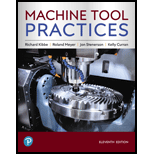
Pearson eText for Machine Tool Practices -- Instant Access (Pearson+)
11th Edition
ISBN: 9780137409129
Author: Richard Kibbe, Roland Meyer
Publisher: PEARSON+
expand_more
expand_more
format_list_bulleted
Concept explainers
Question
Chapter A.3, Problem 10ST
To determine
Safety checklist for the machine tool.
Expert Solution & Answer
Want to see the full answer?
Check out a sample textbook solution
Students have asked these similar questions
CE-112 please solve this problem step by step and give me the correct answer
CE-112 solve this problem step by step and give me the correct answer please
Please do not use any AI tools to solve this question.
I need a fully manual, step-by-step solution with clear explanations, as if it were done by a human tutor.
No AI-generated responses, please.
Chapter A Solutions
Pearson eText for Machine Tool Practices -- Instant Access (Pearson+)
Ch. A.1 - Prob. 1STCh. A.1 - Prob. 2STCh. A.1 - Companies are looking for people with good...Ch. A.1 - Prob. 4STCh. A.1 - Prob. 5STCh. A.1 - Prob. 6STCh. A.1 - Prob. 7STCh. A.1 - Prob. 8STCh. A.2 - Prob. 1STCh. A.2 - Prob. 2ST
Ch. A.2 - Prob. 3STCh. A.2 - Prob. 4STCh. A.2 - Prob. 5STCh. A.2 - Prob. 6STCh. A.2 - Prob. 7STCh. A.3 - What is the primary piece of safety equipment in...Ch. A.3 - Prob. 2STCh. A.3 - Prob. 3STCh. A.3 - Prob. 4STCh. A.3 - What hazards exist from coolants, oils, and...Ch. A.3 - Prob. 6STCh. A.3 - Prob. 7STCh. A.3 - Prob. 8STCh. A.3 - Prob. 9STCh. A.3 - Prob. 10STCh. A.3 - Prob. 11STCh. A.4 - Define the term pitch diameter.Ch. A.4 - Name two ways to measure a thread.Ch. A.4 - What is the rule of thumb for the length of...Ch. A.4 - Describe when class two fits are used.Ch. A.4 - Describe UNC and UNF.Ch. A.4 - What is the formula for calculating the OD of a...Ch. A.4 - When are stud bolts used?Ch. A.4 - Prob. 8STCh. A.4 - Explain two reasons why flat washers are used.Ch. A.4 - What is the purpose of a helical spring lock...Ch. A.4 - When is an internal-external tooth lock washer...Ch. A.4 - When are dowel pins used?Ch. A.4 - When are taper pins used?Ch. A.4 - When are roll pins used?Ch. A.4 - What are retaining lings?Ch. A.4 - Prob. 16STCh. A.4 - Prob. 17STCh. A.4 - Prob. 18STCh. A.5 - Prob. 1STCh. A.5 - Prob. 2STCh. A.5 - Prob. 3STCh. A.5 - Prob. 4STCh. A.5 - Prob. 5STCh. A.5 - Prob. 6STCh. A.6 - Prob. 1STCh. A.6 - Prob. 2STCh. A.6 - Prob. 3STCh. A.6 - Prob. 4STCh. A.6 - Prob. 5STCh. A.6 - Prob. 6STCh. A.6 - Prob. 7STCh. A.6 - Prob. 8STCh. A.6 - Prob. 9STCh. A.6 - Prob. 10STCh. A.7 - Prob. 1STCh. A.7 - Prob. 2STCh. A.7 - Prob. 3STCh. A.7 - Prob. 4STCh. A.7 - Prob. 5STCh. A.7 - Prob. 6STCh. A.7 - Prob. 7STCh. A.7 - Prob. 8STCh. A.7 - Prob. 9STCh. A.7 - Prob. 10STCh. A.8 - Prob. 1STCh. A.8 - Prob. 2STCh. A.8 - Prob. 3STCh. A.8 - Prob. 4STCh. A.8 - Prob. 5STCh. A.8 - Prob. 6STCh. A.8 - Prob. 7STCh. A.8 - Prob. 8STCh. A.8 - Prob. 9STCh. A.8 - Prob. 10STCh. A.8 - Prob. 11STCh. A.9 - Prob. 1.1QCCh. A.9 - Prob. 1.2QCCh. A.9 - Prob. 1.3QCCh. A.9 - Prob. 1.4QCCh. A.9 - Prob. 1.5QCCh. A.9 - Prob. 1.6QCCh. A.9 - Prob. 2.1QCCh. A.9 - Prob. 2.2QCCh. A.9 - Prob. 3.1QCCh. A.9 - Prob. 3.2QCCh. A.9 - Prob. 4.1QCCh. A.9 - Prob. 4.2QCCh. A.9 - Prob. 4.3QCCh. A.9 - Prob. 1STCh. A.9 - Prob. 2STCh. A.9 - Prob. 3STCh. A.9 - Prob. 4STCh. A.9 - Prob. 5STCh. A.9 - Prob. 6ST
Knowledge Booster
Learn more about
Need a deep-dive on the concept behind this application? Look no further. Learn more about this topic, mechanical-engineering and related others by exploring similar questions and additional content below.Similar questions
- Please do not use any AI tools to solve this question. I need a fully manual, step-by-step solution with clear explanations, as if it were done by a human tutor. No AI-generated responses, please.arrow_forwardCE-112 please solve this problem step by step and give me the correct answerarrow_forwardCE-112 please solve this problem step by step and give me the correct asnwerarrow_forward
- this is an old practice exam, the answer is Ax = -4, Ay = -12,Az = 32.5, Bx= 34, Bz = 5, By = 0 but how?arrow_forwardThis is an old practice exam, the answer is Ax = Az = 0, Ay = 2000, TDE = 4750, Cx = 2000, Cy = 2000, Cz = -800 but how?arrow_forwardthis is an old practice exam, the answer is Fmin = 290.5lb but howarrow_forward
- This is an exam review question. The answer is Pmin = 622.9 lb but whyarrow_forwardPlease do not use any AI tools to solve this question. I need a fully manual, step-by-step solution with clear explanations, as if it were done by a human tutor. No AI-generated responses, please.arrow_forwardPlease do not use any AI tools to solve this question. I need a fully manual, step-by-step solution with clear explanations, as if it were done by a human tutor. No AI-generated responses, please.arrow_forward
- Please do not use any AI tools to solve this question. I need a fully manual, step-by-step solution with clear explanations, as if it were done by a human tutor. No AI-generated responses, please.arrow_forwardThis is an old practice exam. Fce = 110lb and FBCD = 62 lb but whyarrow_forwardQuiz/An eccentrically loaded bracket is welded to the support as shown in Figure below. The load is static. The weld size for weld w1 is h1 = 4mm, for w2 h2 = 6mm, and for w3 is h3 =6.5 mm. Determine the safety factor (S.f) for the welds. F=29 kN. Use an AWS Electrode type (E100xx). 163 mm S 133 mm 140 mm Please solve the question above I solved the question but I'm sure the answer is wrong the link : https://drive.google.com/file/d/1w5UD2EPDiaKSx3W33aj Rv0olChuXtrQx/view?usp=sharingarrow_forward
arrow_back_ios
SEE MORE QUESTIONS
arrow_forward_ios
Recommended textbooks for you
 Automotive TechnologyMechanical EngineeringISBN:9781337794213Author:ERJAVEC, Jack.Publisher:Cengage,
Automotive TechnologyMechanical EngineeringISBN:9781337794213Author:ERJAVEC, Jack.Publisher:Cengage, Automotive Technology: A Systems Approach (MindTa...Mechanical EngineeringISBN:9781133612315Author:Jack Erjavec, Rob ThompsonPublisher:Cengage Learning
Automotive Technology: A Systems Approach (MindTa...Mechanical EngineeringISBN:9781133612315Author:Jack Erjavec, Rob ThompsonPublisher:Cengage Learning Precision Machining Technology (MindTap Course Li...Mechanical EngineeringISBN:9781285444543Author:Peter J. Hoffman, Eric S. Hopewell, Brian JanesPublisher:Cengage Learning
Precision Machining Technology (MindTap Course Li...Mechanical EngineeringISBN:9781285444543Author:Peter J. Hoffman, Eric S. Hopewell, Brian JanesPublisher:Cengage Learning Welding: Principles and Applications (MindTap Cou...Mechanical EngineeringISBN:9781305494695Author:Larry JeffusPublisher:Cengage Learning
Welding: Principles and Applications (MindTap Cou...Mechanical EngineeringISBN:9781305494695Author:Larry JeffusPublisher:Cengage Learning

Automotive Technology
Mechanical Engineering
ISBN:9781337794213
Author:ERJAVEC, Jack.
Publisher:Cengage,

Automotive Technology: A Systems Approach (MindTa...
Mechanical Engineering
ISBN:9781133612315
Author:Jack Erjavec, Rob Thompson
Publisher:Cengage Learning

Precision Machining Technology (MindTap Course Li...
Mechanical Engineering
ISBN:9781285444543
Author:Peter J. Hoffman, Eric S. Hopewell, Brian Janes
Publisher:Cengage Learning

Welding: Principles and Applications (MindTap Cou...
Mechanical Engineering
ISBN:9781305494695
Author:Larry Jeffus
Publisher:Cengage Learning
General Industrial Safety; Author: Jim Pytel;https://www.youtube.com/watch?v=RXtF_vQRebM;License: Standard youtube license